EM GUIDE: Listening to Other Realities – Elia Moretti on sound art, the Carpathians and dissidence
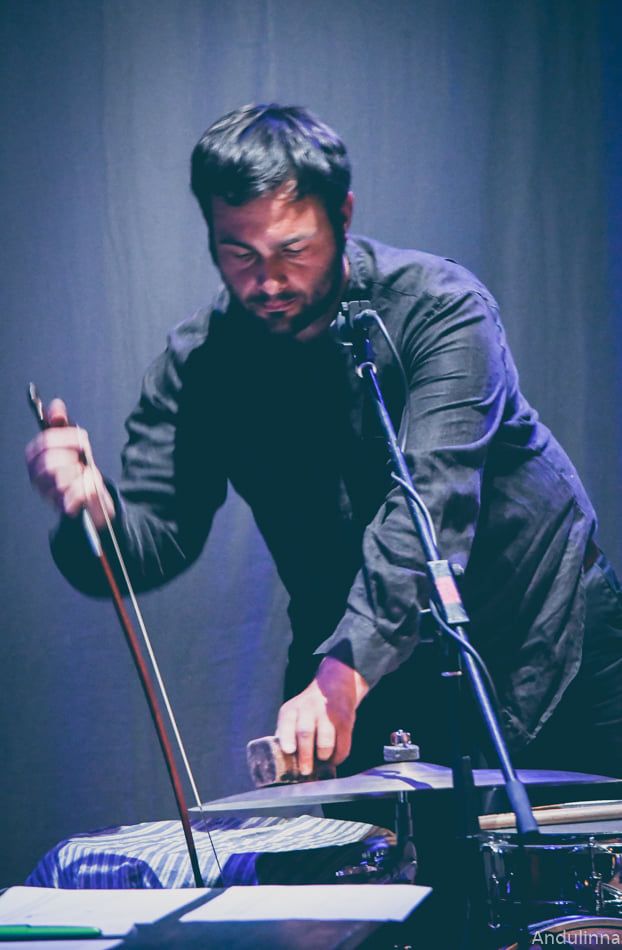
Hi Elia, I would like to start our conversation with a personal reminiscence.
I first met you in 2019, when we started our PhD studies the same year as new colleagues. Before our first semester, I randomly met your wife, theatre director and curator Marika Smreková, and your daughter, Emília, at a workshop during an Extinction Rebellion gathering on the Venceslav Square, not realising any connections. Your daughter gave me a back massage as we sat on logs, and she was interested in a black and white pattern on my shawl. Sometime later, I met Marika and Emília again, and a friend from Stará Ľubovňa introduced us. And Marika realised that you and I must be new colleagues now. I feel almost nostalgic for the period when our PhD journeys started because we have all faced so many crises since then. How are you doing at this time?
Oh, Dominika, that picture is so beautiful. Thank you for remembering it. Bittersweet, yes, the last few years have been very hard. But the destruction was already there and in a very advanced state. That’s why we went to the Extinction Rebellion demonstrations. I share your nostalgia, but I often wonder how to act in this chaos. We’ve reached a point where it’s difficult to imagine how to exist in such complexity. So instead of hope, I need to understand how to live in such a difficult world.
Our second daughter, Marina, was born this April. Marika and I have a long period of caring ahead of us, which is an opportunity to invent new ways of caring for each other. It’s necessary to look inward and experiment with new forms of existential and political dissidence. Is that too much?
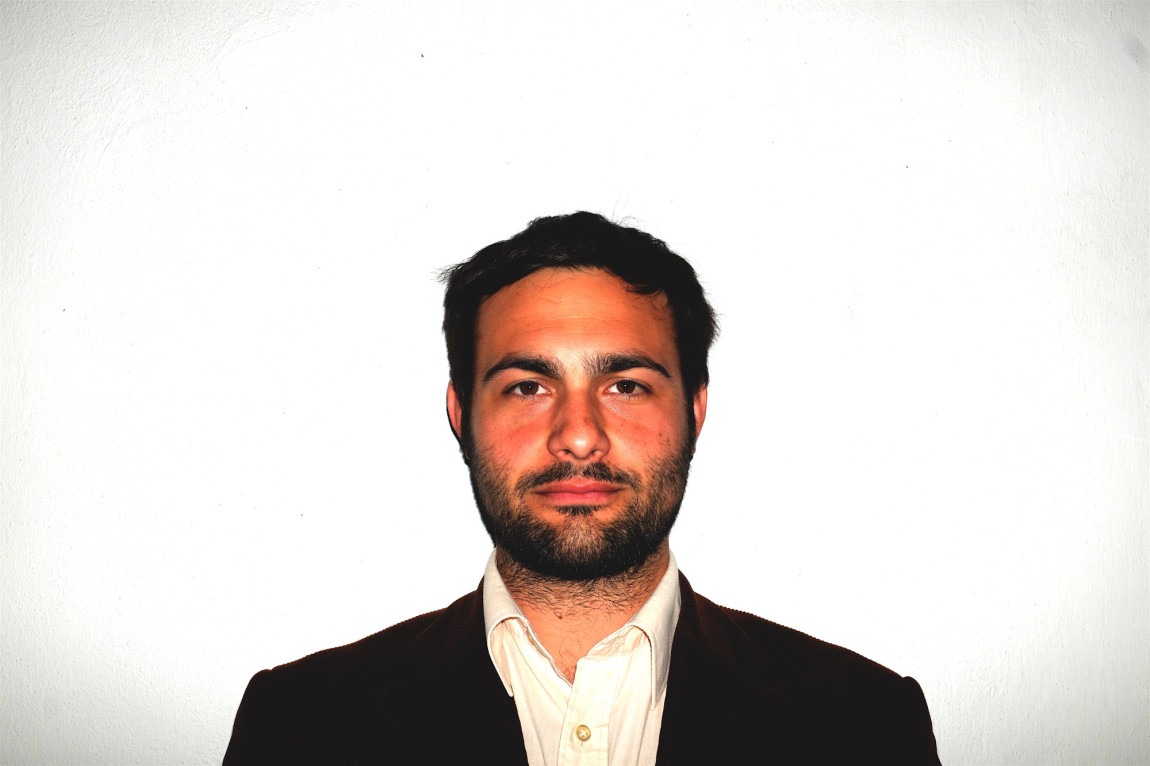
photo: Pierre Louis Barge
As you said, it is probably a necessity. Dissidence is a fitting word for this condition of misalignment with the current rise of right-wing politics and the continuous anthropogenic breakdown of the natural environment. I hope your young family will have the right conditions for caring, growing, and experimenting, especially in today’s uncertainty.
Your PhD supervisor is Tereza Havelková, a musicologist and expert in contemporary opera. Her book Opera as Hypermedium: Meaning-Making, Immediacy, and the Politics of Perception, published in 2021, has resonated in the global musicological community. Tereza is also your collaborator and dramaturg of your composition “Once Enea stuck an apple seed to my ear,” created for rAdioCUSTICA, an Intermedia project of Czech Radio Vltava. How do you benefit scholarly and artistically from this relationship?
Pier Paolo Pasolini said: “We can only do real things in the company of friends”. I feel very lucky to have met Tereza, she is such a forward thinker. She always has a new concept in her pocket and I’m really impressed by her sharp analytical and critical skills. I think what has brought us closer is a political awareness of the cultural analysis of music theatre and sound. Especially the potential that lies in the relationship between performance and audience, between the perceiver and the perceived.
How did you two first meet each other?
It was a stroke of luck. It was 2018 when I was invited to curate the festival Hear Me. The framework was the performativity of sound and I thought it would be interesting to have not only performances but also a reflection in the afternoons. At that time I was still living in Prešov and I found out that the IFTR (International Federation for Theatre Research) Annual Conference was going to be in Belgrade. IFTR conference is a big theatre meeting that goes around the world and it is organised with panels in the afternoon and working groups in the morning. Tereza became co-director of the music theatre working group of the IFTR that summer. That’s where we met for the first time.
In this piece for Czech Radio, we explored the act of listening itself, how to achieve a composition or a device that helps us to “listen to ourselves listening”. Radio can create intimacy without proximity, it shares particularity. It’s a kind of theatre where you don’t see. Where a simultaneity of personalities coexists, each experience requires negotiation and listening becomes agency. Thinking as an academic and making as an artist: is such a luxury. It worked very well artistically. The composition won two awards, Phonurgia Nova and Prix Palma Ars Acustica. What is more, we were able to confront ourselves with a different expertise, which allowed us to explore a new language and establish a different confrontation.
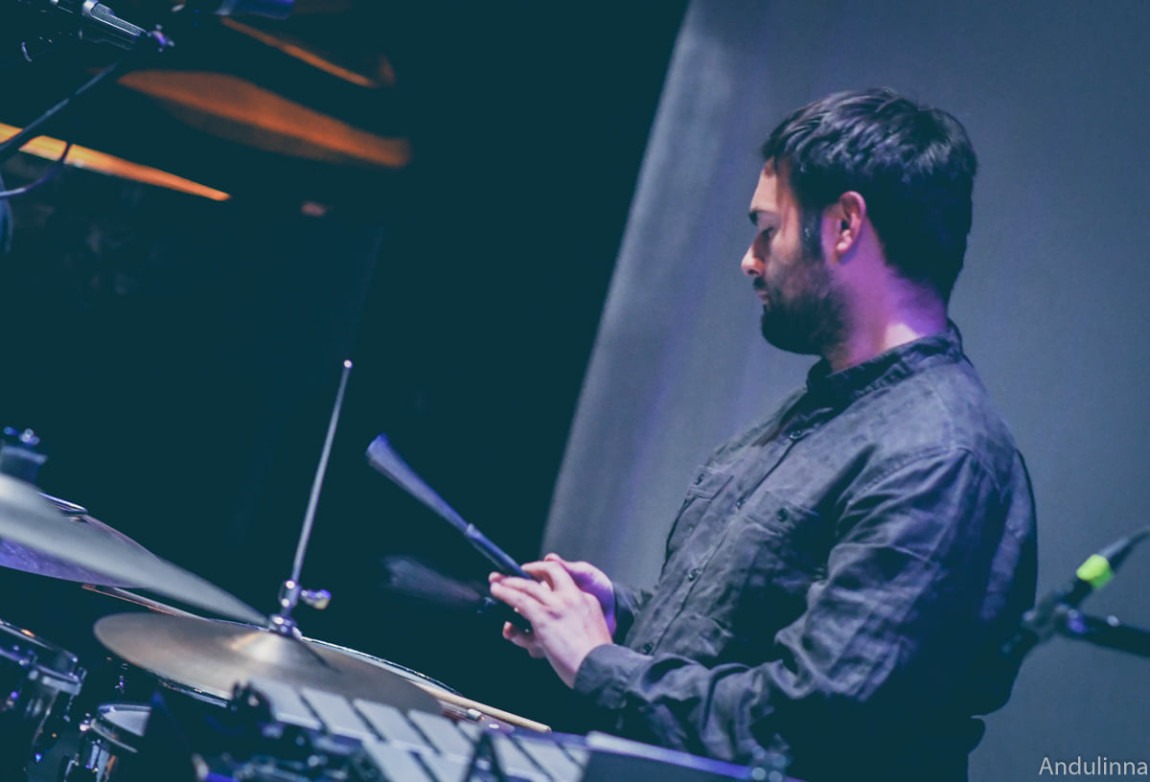
photo: Anna Baštýřová
That sounds like a rich collaboration. It is great that the entire composition is available for listening on the Czech radio website.
Your dissertation project is based on Practice-Based Research. This type of research is very unusual in the context of the Institute of Musicology at Charles University, which was founded on and is mainly preoccupied with other academic traditions. As far as I know, you are the only scholar and member of the department who currently deals with practice-based research. Could you tell us more about this approach in your work? Do you have any idea why is this line of research so rare in our musicological community?
In music, performance and the humanities research, methodologies are less easily defined, since we are often trained through ‘communities of practice’ (Wenger 1998). Musicology did not appear in the universities until in the 19th century, primarily in Germany. The United States adapted the German model, according to the professionalisation needs of the industrial age. Music tried to fit the model of positivist science, and this provoked an imbalance: a source of uncertainty for the field of music, where practitioners in the music sector in Central Europe rarely take an interest in research ideas emerging from musicology departments. Similarly, academics are perceived to take an interest in practice only selectively or in instrumentalising ways. This mutual disinterest has created a gap of ambivalence between the academic study of music and the actual music-making sector. This leads to a gap between theory and practice. I think it is important to either bridge this gap or to free practice from imposed theories.
Meeting Tereza Havelková gave me hope. I was allowed to experiment with rather new approaches such as Practice Based Research.
However, I still feel like an outsider in the musicology department. My methodology has not been rejected, it has aroused interest, but it has not been fully accepted. I have been invited to continue my practice and to write about it. Because it’s only the written texts that are examined and evaluated. What’s more, the department doesn’t provide any extra funding, space or time for my practice. So I have to fit fundraising, rehearsing, training and performing into my research time and still try to meet deadlines.
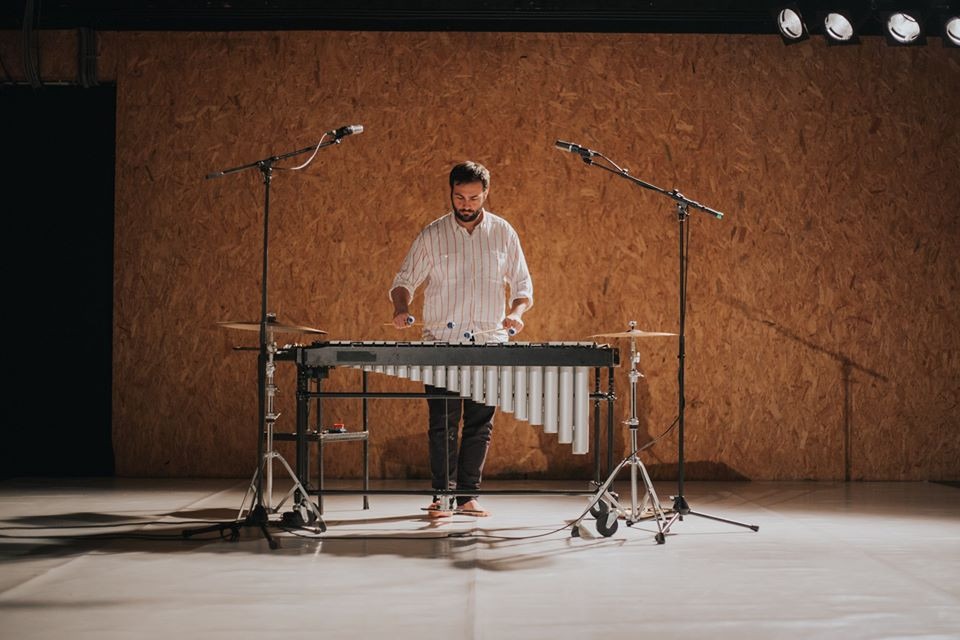
photo: Katarina Baranyai
That must be really difficult, considering that our PhD programs are underfunded to begin with. Do you think the university should have a PhD program that would better assist you in your journey as a practice-based researcher? What could be done to improve the current state, besides better funding itself?
It is possible to do artistic practice-based research at academies in the Czech Republic. However, I think that the university would also benefit from a wider range of methodologies, beyond the artistic disciplines. There is much to be learned from the differences, gaps and tensions between each type of knowledge and each type of practice. Also, a curriculum that was relevant in the past or elsewhere may no longer be so, and vice versa. In particular, I would focus on creativity and agency, and the sense that one has the capacity to engage, initiate and consciously influence one’s circumstances, which is crucial from earlier stages of education.
During the Month for the Faculty, a series of events was organised after the tragic mass shooting in our faculty building, you initiated a performative walk for the members of our institute and the broader academic community. When you pitched this event during our meeting with the students, you emphasised simplicity. Can you share some thoughts on performative art practices and strategies in the context of enormous collective grief?
It was an incredible shock for all of us. In the aftermath of the tragedy, the University offered strong psychological support to everyone affected. So when students organised themselves in January in a series of activities called Month for the Faculty, I thought I would support the Faculty of Arts of Charles University (FF UK) by leading a sound walk to give people a chance to think about the cultural, political, sonic and social meanings of the everyday sounds of these places. There were two main points I wanted to address: peer relationships and the role of creativity in mental health.
The aim was to explore the relationship between each of us and to reframe listening as an encounter. The practice of the Soundwalk is quite simple, and that’s why it’s so effective: it intensifies the presence of what is. Listening is a contingent activity that draws relationships in the fragility of what it might be at any given moment, rather than what it might be permanently. It emphasises the structure of the environment itself and sees perception as the reception of this already structured information according to three factors: the relationship between perception and action, adaptation, and perceptual learning.
A practice like the Soundwalk doesn’t make a statement but opens up periods of attention that allow us to welcome the manifestations of a situation or dimension.
How did you organise the sound walk?
I brought some simple tuning exercises and some open scores from the Fluxus period – each of us was invited to interpret and perform the instructions in our own way. I tried to pass on the leadership of the group because I wanted them to experience the role of guide as well, and to understand that anyone can facilitate this kind of practice.
As for the collective mourning, my focus was more on contextualising this practice as a way of empathising with things, and caring for others, while inviting each of us to reflect on how we manage our singularity in a collective society. We spent most of our time in Palach Square and along the river, ending with a walk around the FF UK building and listening to the melting of wax at the perennial fire installed for the Month of the Faculty, right next to the Rudolfinum.
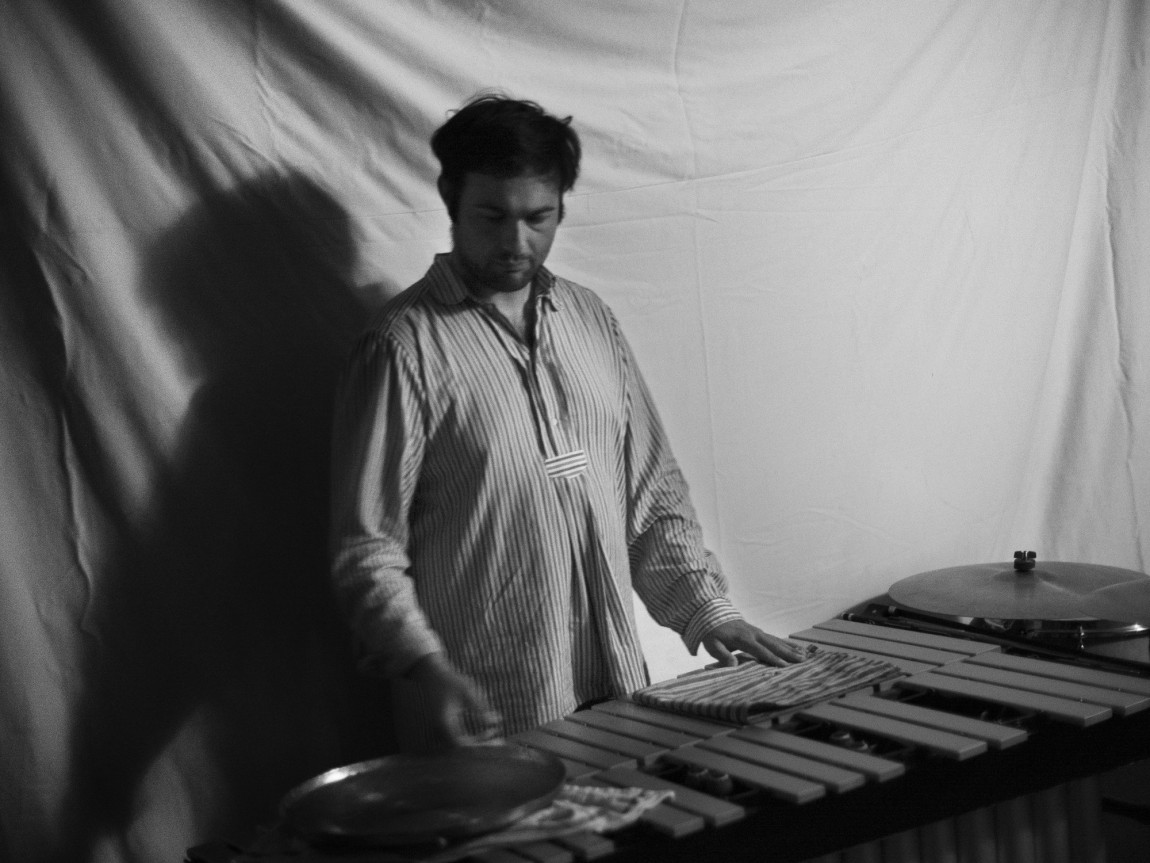
photo: Klaas Boelen
That indeed sounds meaningful and well thought out. And thank you for this precious contribution to the healing of our community.
Now I would like to take this opportunity to ask you about your projects in Slovakia. Your practice-based research has led you to the Roma settlements in Eastern Slovakia, particularly around Stará Ľubovňa and the Carpathian Mountains. You and Marika have established in Prešov a series of sound workshops and performances called Carpathian New Wave. You both also initiated a project titled Symposium Musicum that rose from the community festival of contemporary theatre and art UM UM. The project deals with environmental sounds in the context of territorial transformations. Recordings from this project resulted from various sound explorations and interactions with people from multiple villages with Roma populations. Why did you and Marika decide to explore the mountainous Carpathian region through fieldwork and participatory sound practices?
Well, perhaps we should take a chronological approach to this one. Marika was born in Stará Ľubovňa and while studying directing at JAMU in Brno, she founded the UM UM festival in her home town. The festival began as a provocation to see what would happen if she took experimental theatre and art to the periphery, in non-theatrical and public spaces. But it soon took on a political dimension. The trigger was the rise of the Slovak far right in 2016 when an extreme-right nationalist party won seats in the parliament. Therefore, in the following editions of UM UM, Marika decided to explore the historical and contemporary relations of Slovak society with another ethnic group (i.e. Czechs; Ruthenians; Jews; Carpathian Germans; Romani; Poles; and Hungarians). Each edition of the festival was the culmination of a year of research, during which Marika and her collaborators met and listened to various local people. The results of this research were transformed into the creation of a participatory performance where all these people could meet and take part in a multicultural dialogue, that is, alas, disappearing.
The Carpathian region enjoys and blends a confluence of diverse influences from the cultures that surround it, both historically and today, creating a unique perspective (Deleuze would say ‘minoritarian’). I have a soft spot for outsiders and weirdos – strangers to the world of art education and conventional art, who consciously or unconsciously recoil from the official system. The valuable position of making experimental art in a so-called ‘periphery’ is that this process can have an originally authentic base and a more independent development through sharing, experimentation and failure in the light of a heterodox approach.
However, I do not agree with a centre-periphery dichotomy, the art situated in this place cannot be seen as just geographically specific, it has to be seen as an expression of “positionality”, in the sense of an actual political position.
The activities you mentioned that I’ve been carrying out in the Carpathian region have been a series of proposals aimed at rethinking the Carpathians and re-imagining their possible futures, understanding them as complex spaces actively immersed in the dynamics of encounters, flows and fluxes of contemporary geographies, and critically questioning the modernist discourses of capitalism and metropolitanism in which they are marginalised and considered condemned to oblivion.
Sound invites us to question our relationship to spaces, as well as our approach to history and landscape. Listening practices have helped to challenge the notions of marginality and peripherality in the Carpathians.
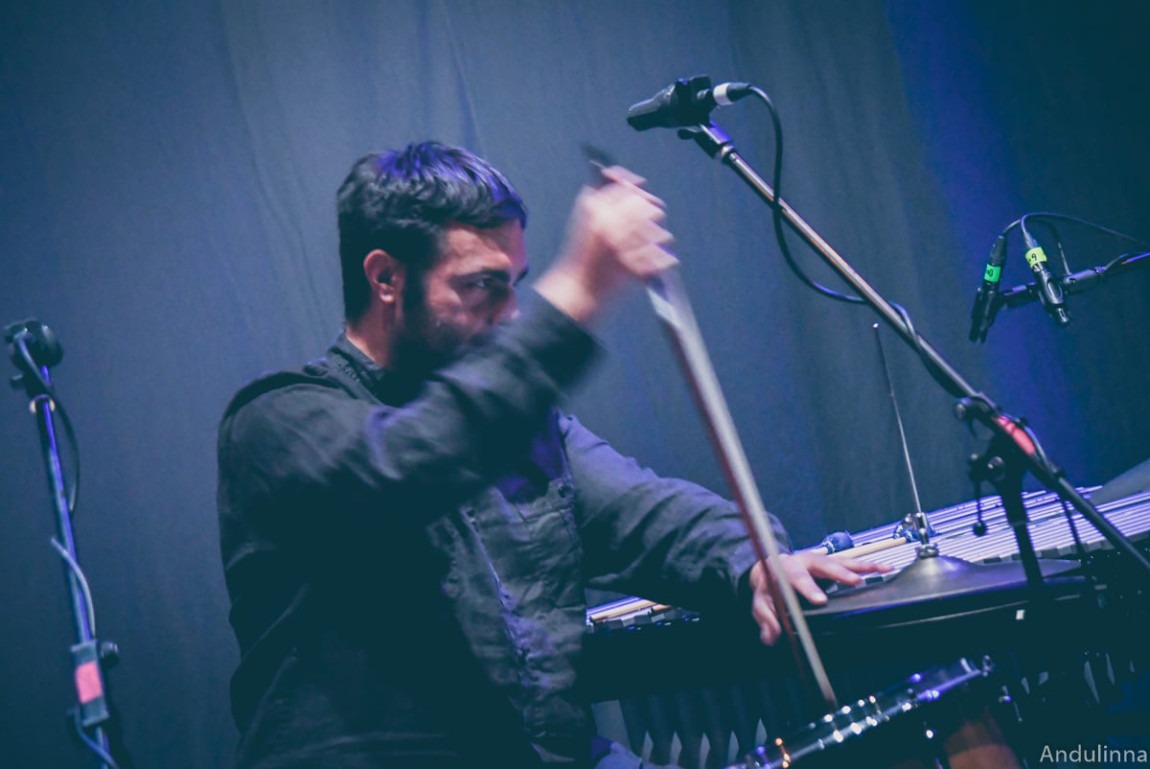
photo: Anna Baštýřová
Was it difficult to engage with the issues of Romani marginality in Slovakia as an artist who is an outsider to the local racial relations and injustices associated with them? What is your positionality on whiteness in Slovakia as a person who was not brought up and culturally conditioned to live in and perform this racial hierarchy?
Unfortunately, it was not difficult. Discrimination against the Roma in Eastern Slovakia is such an obvious phenomenon. The violent segregation is so evident that you don’t have to spend much time there to observe it. And yet, it is important not to tell this story as one that focuses entirely on the lack of Roma agency, on loss, or on what American Indigenous scholar Eve Tuck calls ‘damage-centred’ narratives.
In 2019, Symposium Musicum (where I participated together with Anna Khvyl, John-Robin Bold and Marika Smreková) was the opportunity to listen to what kind of relationship Roma and Slovaks have in contemporary society. Symposium Musicum emphasised subject-to-subject relationships, moving beyond a listener-centred view and valuing the agency, life and subjectivity of sound itself. By being aware of our listening positionality, we engaged with the aurality of communities and explored the political dimensions within. This exploration enriched our understanding of the politics inherent in sonic practices and contributed to a more inclusive and fair engagement with diverse communities.
The album Symposium Musicum is based on recordings made in multiple villages, including Lomnička, almost exclusively a Romani settlement with around 3000 inhabitants. According to the locals, you and your team were the first non-Romani persons to spend the night in this village. Recently, the former prime minister and populist politician Igor Matovič visited Lomnička and posted a sentimental and self-congratulatory text about this experience on his Facebook. The text was loaded with cliches about Romani’s authenticity and happiness against all odds, and he also mentioned how the local people praised his former government. And by the way, in December 2023, the Union of Roma filed a criminal complaint against Igor Matovič for populist manipulation of poor Roma. Matovič has made a pretty ludicrous proposition to give 500 euros to everyone who will participate in the election, which, of course, had never materialized. Many Roma borrowed money from usurers before the election and never received the promised compensation. What do you think about populist campaigns in social peripheries? Do you consider Symposium Musicum to be educational or activist work in some capacity?
There is a moral imperative to try attempting such dialogues, imperfect as they are. My suggestion would be to listen first, to attune. Attunement means tuning in, listening and making adjustments to create harmonies or relationships between things and people. Attunement in this context requires tuning into places and communities. We create relationships and we live together. Attunement is based on asking questions. It invites us to encounter the unknown and, more importantly, the unknowable.
It’s a kind of decolonisation of listening that requires a complete undoing of how we are taught to listen. Narrowly understood as dependent on ears and voice, listening is understood as a tool for sharing language. Listening, like all communication, is trained. It is culturally and geographically specific, shaped by social, political and economic forces, violence and oppression.
Yet we are expected to listen in a universal way. The fallacy of this is clear when you consider that although we assume we are listening carefully, being unheard, misheard or misunderstood is a common complaint.
This is a work that takes time, until the moment when people and places tell me what they want from me, what I can be in service of; becoming familiar with what is incomplete, unknown and ultimately incommensurable. This is an approach that requires material access to sound and transcends the concept of representation. The challenges and social transformations that inform the ideological and infrastructural ecosystems of which they are a part have been exposed. From this point of view, aural attention engages with processes linked to politics and social relations.
You wrote the following about the project Symposium Musicum: “I believe sound can achieve formerly removed cultural elements” and can “traverse borders, challenging marginality and periphery.” At first glance, this may sound rather optimistic. But I think I know what you mean. The statement is not one of those idealistic proclamations about music as a universal language, but rather, it is about the materiality of sound that can be aesthetically and ontologically autonomous and removed from the injustices, violence, and silencing that rises not only from punitive regimes of government but also from culture – in forms of expectations, cliches, and essentialisms. What were the reactions of the listeners to the album? Did they feel challenged?
It is very easy for artists to create superficial work that reproduces dominant inequalities. I have been thinking more critically about my own role as a scholar and artist, and about the economic and political infrastructures that I have been involved with.
The key requirement for this experiment is a long-term commitment. The UM UM festival provided a foundation for Symposium Musicum in 2019, while there was initial scepticism about releasing the LP with mappa in 2023. The intention was not to create solely an object or advertise artistic activities. Instead, it was called “social sound practice” and seen as a tool to create conditions for a Slovak-Romani encounter or to pique the curiosity of listeners far from the Carpathians.
The LP was well received, we were invited to festivals in Slovakia and abroad, or radio. We received international interest and were included in some best-of-the-year lists (eg. Bandcamp – The Best Field Recording of 2023). But let me say that this challenge is never enough, especially in Slovakia.
A significant phase of this project was a sound installation in the building of the bus station in Stará Ľubovňa. This city is one of the most racially segregated places in Slovakia. How did the locals perceive this intervention?
Sounds and music were brought into a public and liminal space, deliberately marking a certain kind of disturbance or intervention in our senses and cognition.
One lady in the waiting room was very worried. She was actually really upset, she rejected Roma in any form, even in the invisible and ephemeral dimension of sound. However, this provoked a conversation with some of us. Several people had similar negative reactions: a good and safe starting point for intercultural dialogue.
We built the installation in a performative way. It ran all day on 2 September, the first day of school. Each of the feedback that came from people passing by or living in the waiting room became a reason for confrontation.
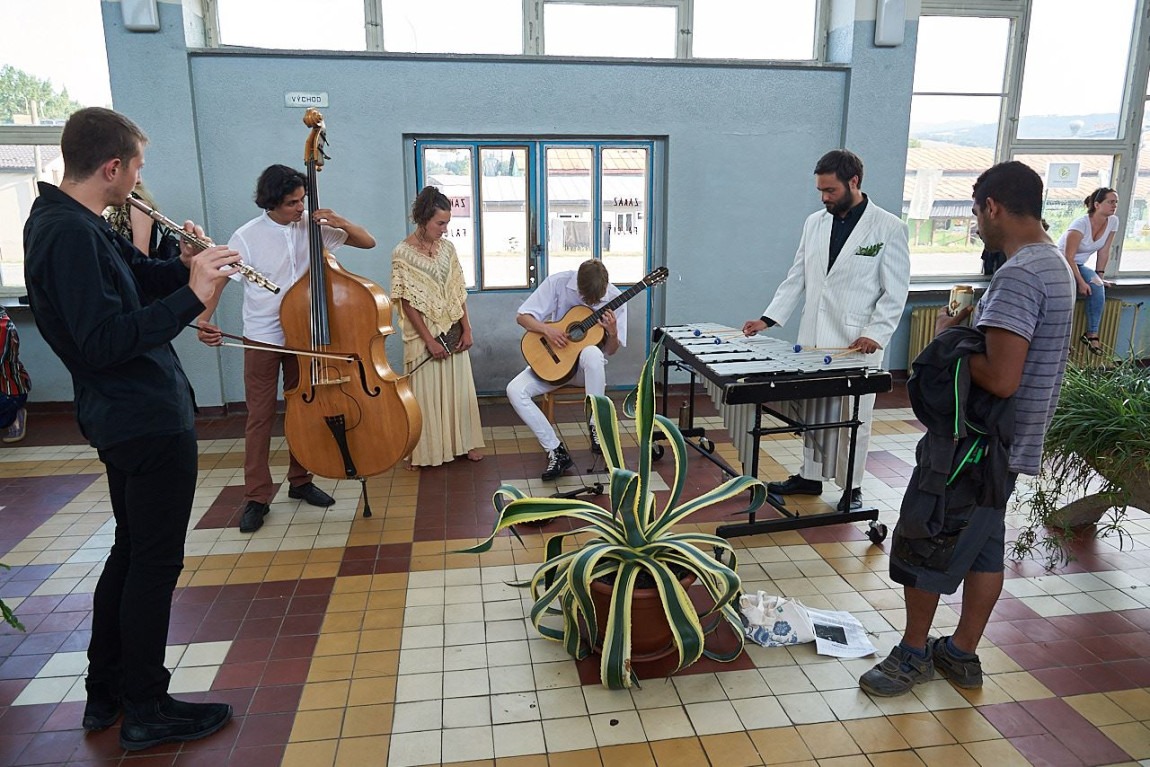
photo: Slavo Uhrin
Suddenly, in the afternoon, a man came in with muddy shoes and a big smile. He must have recognised the rural soundscape in which he lived. He said we should have visited him on the pasture where he works. He didn’t comment on the relationship between Roma and Slovaks.
There were several Roma at the bus station that day. Some of them approached us with an attitude of confidence. But how do you evaluate such a performance? How do you get feedback from random travellers? How do you judge if and when the performance was transformative?
These are the big questions. Thank you for recalling these moments of interaction with the sound art in an unusual or unexpected place. Do you believe that sound installations like this one also belong in conventional exhibition spaces?
Yes, it is possible. A different context would have a different effect. The sound installation aimed to create a sound that was performative and independent of the authors and original sources of the sound material. A sound that invites a process that, instead of decoding the world, engages the world in a dynamic process with the given context. An installation that seeks an alternative to symbolic representation, avoiding the appropriation of cultural traits of the Roma and Slovak populations we met during our fieldwork, but rather creating a condition of and for knowing through listening. In other words, the installation creates an alternative way of encountering the world and the possibility of listening to other realities.

This article is brought to you by 3/4 as part of the EM GUIDE project – an initiative dedicated to empowering independent music magazines and strengthen the underground music scene in Europe. Read more about the project at emgui.de.
Funded by the European Union. Views and opinions expressed are however those of the author(s) only and do not necessarily reflect those of the European Union or the European Education and Culture Executive Agency (EACEA). Neither the European Union nor EACEA can be held responsible for them.